Some Leaves in Set 1 of Ege’s FOL Portfolio
June 19, 2020 in Manuscript Studies
Leaves from
‘Otto Ege Manuscripts 8, 14, 19, and 41’
In a Newly Discovered Portfolio
of Fifty Original Leaves (“FOL”)
[Published on 18 June 2020, with updates]
[Update on 22 January 2021: This set, sold at auction at Christie’s in London on 8 December 2020, has been acquired by the Houghton Library at Harvard University, as announced by John Overholt.]
Continuing our series of blogposts (see our Contents List) on some manuscripts dismembered and dispersed by Otto F. Ege (1888–1951) in various Portfolios or by other means, we report on selected leaves which emerge into view in a newly discovered set of the Portfolio of Fifty Original Leaves (“FOL”).
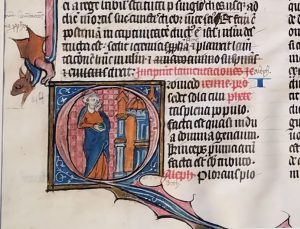
Set 1 of Ege’s FOL Portfolio, Leaf 14 recto: Initial for Lamentations.
Among the numbered sets, the ‘new’ one has the Number 1. This “previously-unknown” set of Ege’s “Fifty Original Leaves” in private hands is reported by our Associate Lisa Fagin Davis in her blog: Manuscript Road Trip: Otto Ege, St. Margaret. and Digital Fragmentology, Part 2 (June 7, 2020), following her Part 1 describing her own and other scholars’ work — ours included — on the FOL manuscripts: Manuscript Road Trip: Fragmentology in the Wild (July 14, 2019).
We thank the owner and Lisa for allowing us to see images of the relevant leaves in the new set, resulting in updates for the manuscripts which we have already considered within Ege’s FOL Portfolio. A complete set of the Portfolio contains ‘Ege MSS 1–50’, as numbered both by Ege and by Scott Gwara in his book on Otto Ege’s Manuscripts (2013).
Here, augmenting our work already on survivors from some of those Fifty manuscripts in other settings (sets of the FOL Portfolio and elsewhere), we focus on Ege MSS 8, 14, 19, and 41. This post contributes to our on-going study of Ege’s manuscripts and other materials, medieval and other, Western and more. So far: Ege MSS 8, 14, 41, 51, 56, 61, and 214 (see our Contents List).
The FOL Portfolio
This Portfolio series is one of several Portfolios which Ege devoted to specific titles or genres of books in manuscript and/or print (such as the Bible in several languages). Our blogposts have examined several of those different Portfolios. Ege gave this one the title of Fifty Leaves from Medieval Manuscripts, XII–XVI Century [sic]. Selecting 1 leaf from each of the 50 manuscripts, he set them in a sequence numbered as “1–50”. Their source manuscripts, accordingly, are known in Scott Gwara’s Handlist of Ege’s manuscripts as “Ege Manuscripts 1–50” — of at least 1–325, and counting. known to have been owned by Ege. A core study online of the FOL Portfolio, in ege.denison.edu, is devoted to the specimens in 12 sets preserved in selected institutions in the United States and Canada.
A provisional summary of the contents of this Portfolio and some of its known sets appears online unevenly in The Otto F. Ege Palaeography Portfolio: Towards a Virtual and Interactive Reconstruction of Fifty Dismembered Manuscripts. Virtual reconstructions of one and another of the FOL manuscripts continue to emerge, as with FOL Leaf 15, the 14th-century Beauvais Missal, expertly reconstructed by Lisa Fagin Davis.
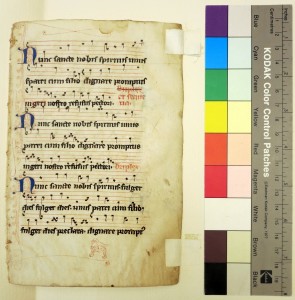
Beinecke Rare Book and Manuscript Library, Otto Ege Collection, Family Album, Specimen Leaf from ‘Ege Manuscript 8’, Recto.
We now update our previous reports of these FOL Manuscripts:
- A New Leaf from ‘Otto Ege Manuscript 8’
- A New Leaf from ‘Otto Ege Manuscript 14’
- More Discoveries for ‘Ege Manuscript 14’
- Updates for Some ‘Otto Ege Manuscripts’ (Ege MSS 8, 14, 41, and 61)
- A Leaf from ‘Otto Ege Manuscript 19’ and Ege’s Workshop Practices
- A New Leaf from ‘Ege Manuscript 41’
- More Discoveries for ‘Otto Ege Manuscript 41’
We present the leaves in Ege’s numerical sequence.
*****
Ege MS 8
The Wilton Processional
Noting the presence of this leaf in the newly discovered Set 1 of FOL, I include the images here, but leave the description and analysis to our Associate, Alison Altstatt, whose expert study of the manuscript as well as its setting inspire admiration. As here: Re-Membering the Wilton Processional, in Music Library Association, Volume 72, Number 4 (June 2016), pp. 690-73.
Recto (Turned to the Verso in Ege’s Mat)
Ege’s characteristic linen hinge-tapes mount the leaf to the mat in a series of 3 tapes. Ege turned the more decorative side of the leaf to the front.
Here, on the original recto, brownish stains from shelfwear acquired by the closed volume in storage across time edge the outer margin at the right. Dark stains extend most of the length of the former inner edge, which has an uneven cut severing the leaf from its companions.
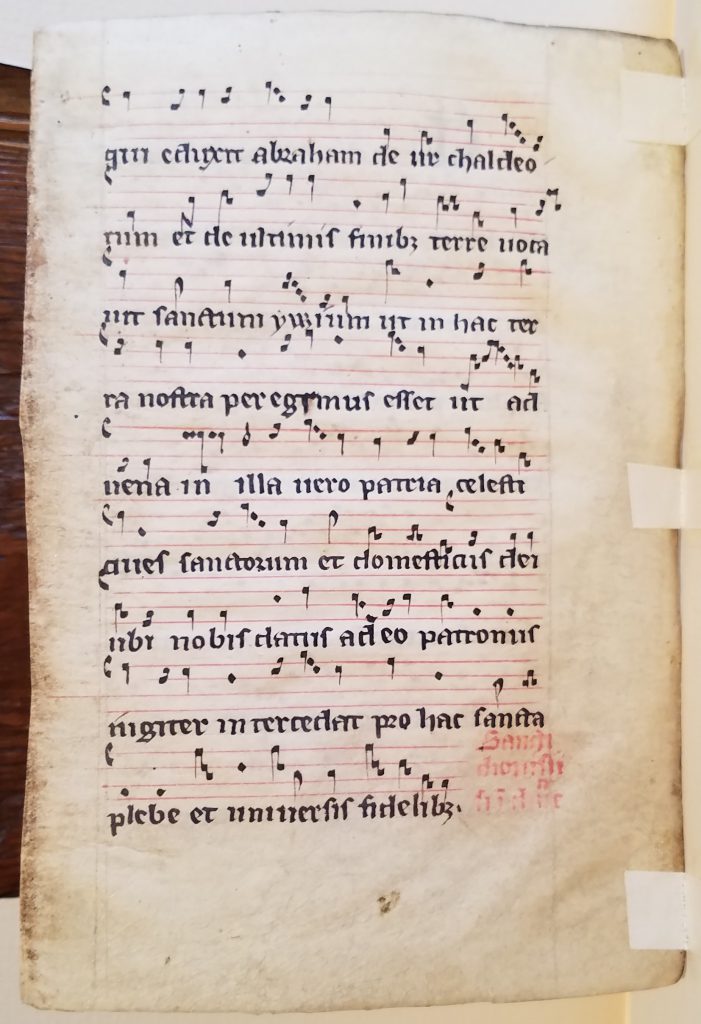
Set 1 of Otto Ege’s FOL Portfolio, Leaf 8 original recto (Ege’s verso).
Verso
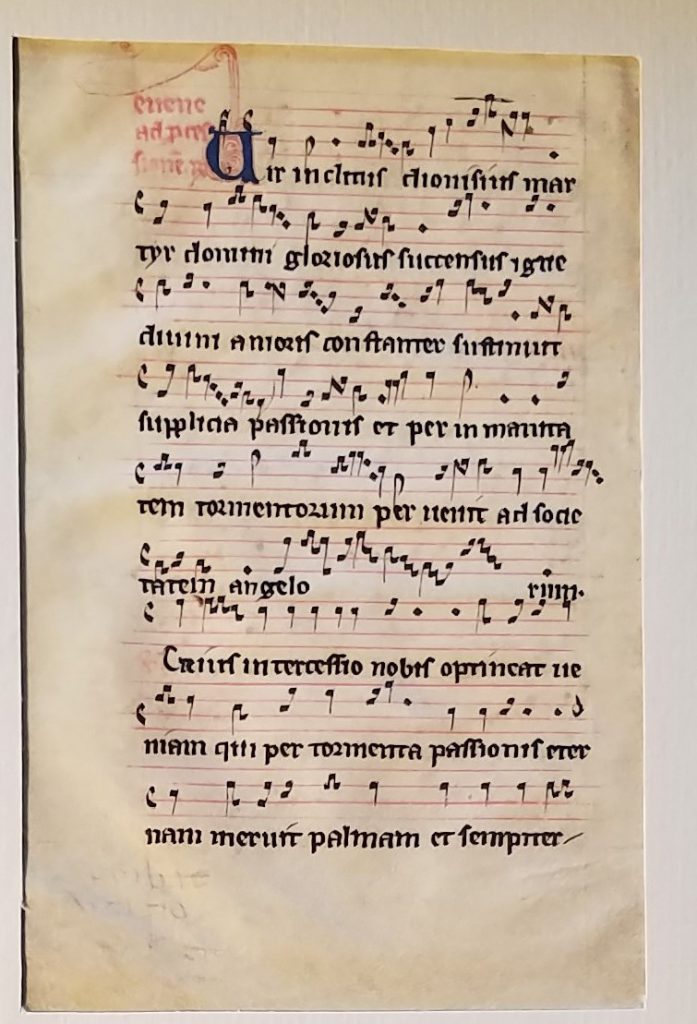
Set 1 of Otto Ege’s FOL Portfolio, Leaf 8 verso (Ege’s recto).
Detail
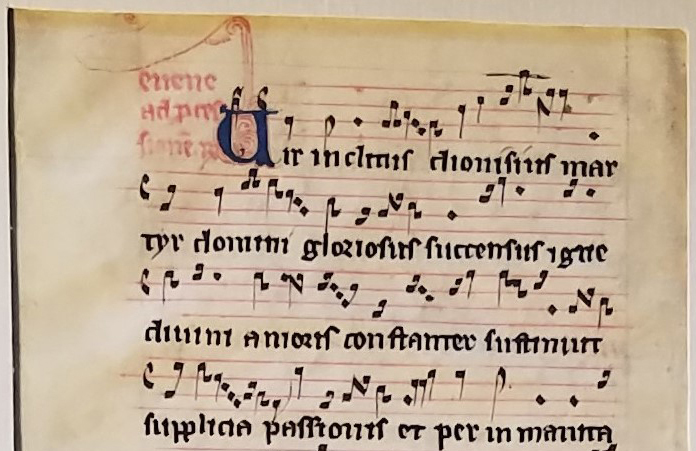
Set 1 of Ege’s FOL Portfolio, Leaf 8 verso top.
We look forward to Alison’s updates for this manuscript. To judge by the leaf by which, during long-term conservation and research, we first learned about the manuscript (first published in A New Leaf from ‘Otto Ege Manuscript 8’), it would have formerly been a book to sit well when held in the hands. It is a treat to see Alison bring it back to life with its sounds as intended for performance.
*****
Ege MS 14
Large-Format Latin Vulgate Bible
- A New Leaf from ‘Otto Ege Manuscript 14’
- More Discoveries for ‘Ege Manuscript 14’
- The Illustrated Handlist, Number 4
- Updates for Some ‘Otto Ege Manuscripts’ (Ege MSS 8, 14, 41, and 61)
Recto in Ege’s Mat with his Label
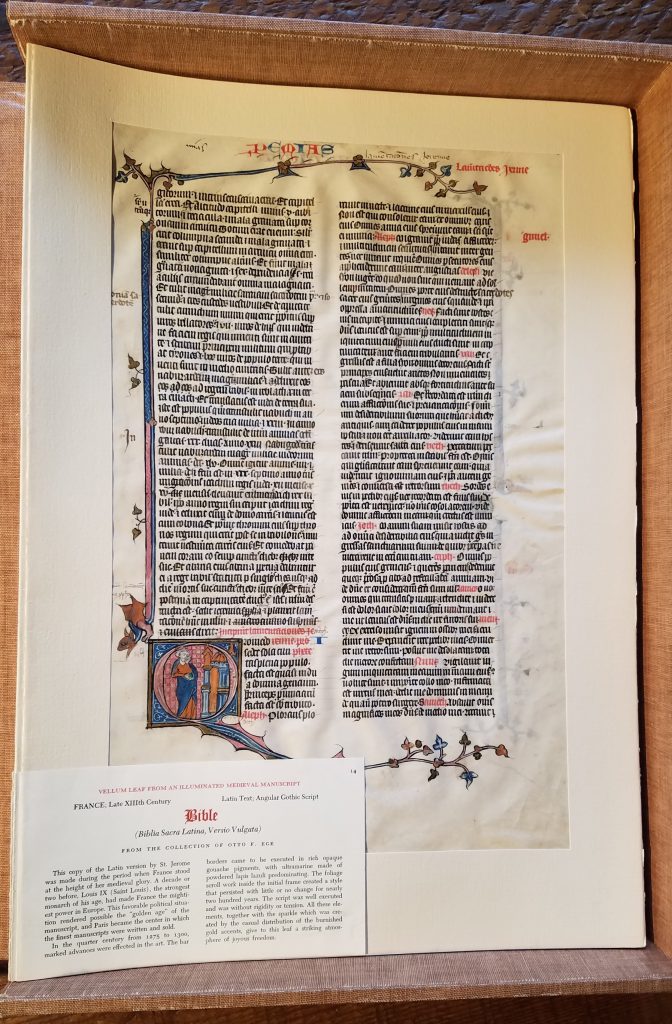
Set 1 of Otto Ege’s FOL Portfolio, Leaf 14 recto.
Recto of the Leaf
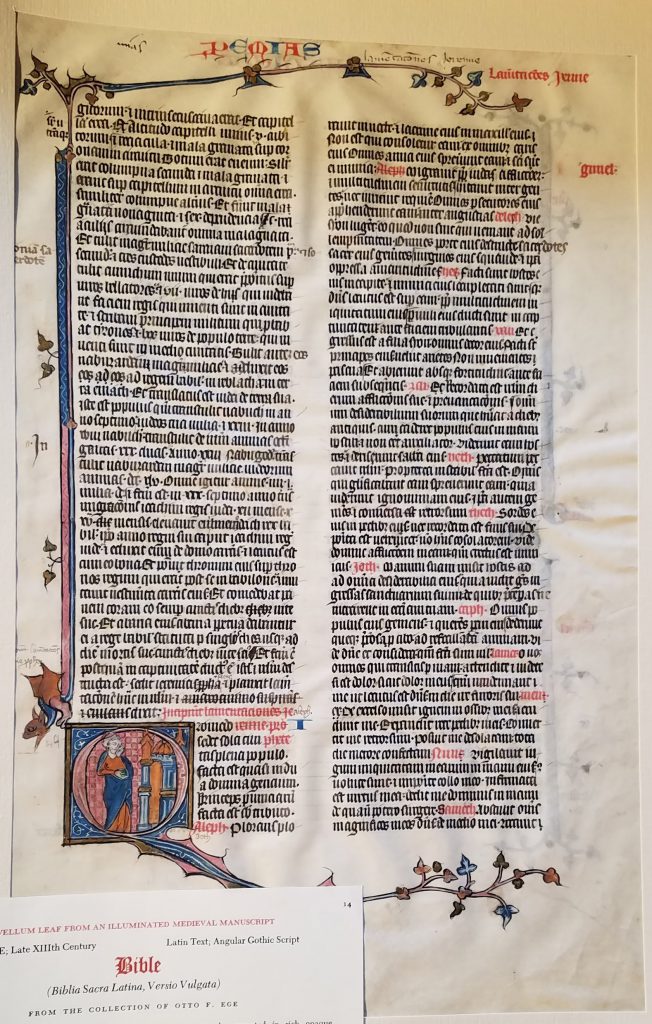
Set 1 of Ege’s FOL Portfolio, Leaf 14 recto.
Verso
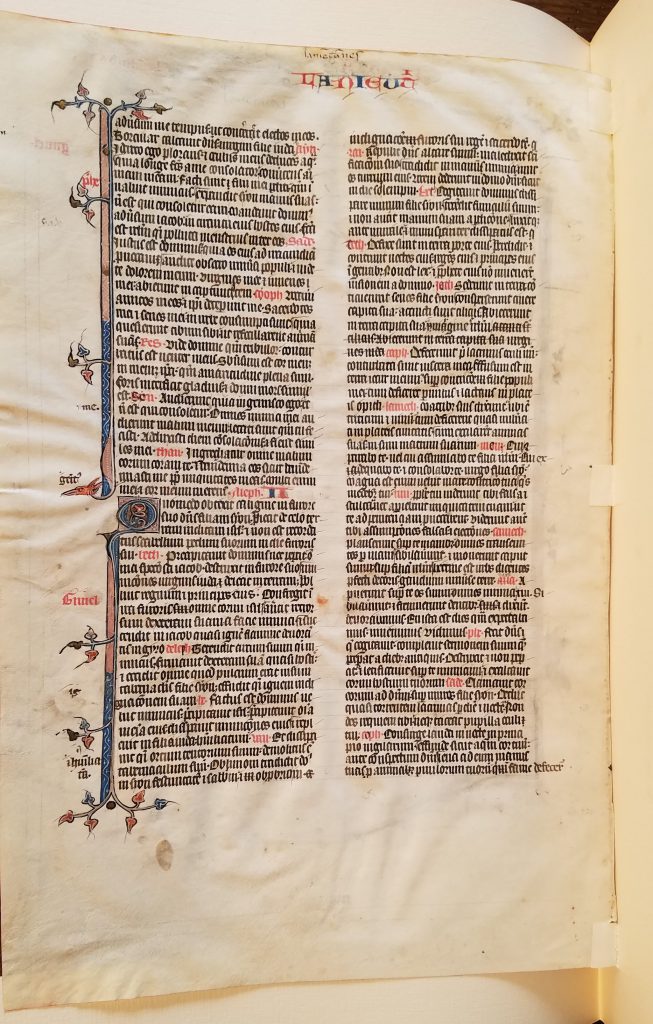
Set 1 of Ege’s FOL Portfolio, Leaf 14 verso.
Contents
This leaf contains the transition between the Old Testament Books of Jeremiah and Lamentations. The recto closes the last chapter of Jeremiah, from mid-word within 52:21 ([quattuor de-/]gitorum) to the last verse (52:34). Opening with a rubricated 3-line title and the decorated initial Q for Quomodo, the Book of Lamentations extends from 1:00 – 2:19, within which it breaks off with qui defecerunt [/ in fame]. Shoved into the margin after the last line of text, the abbreviated word defeceru’ seems like an afterthought in the process of transcription moving from one leaf to the next.
Details
1) Opening the Leaf
The leaf opens with several running titles. In Gothic Capitals alternating in red and blue letters, the more-or-less centered portion on the recto of the 2-page spread offers the right-hand part presumably of [IE-/]REMIAS. Offset to the right, beyond the terminals of the extended foliate motif across the upper margin, there stands in red another title: Lamitationes Ieremie, identifying the new Book which opens partway down column a.
In script and pigment, this identifier resembles the transcribed names of the Hebrew letters which head the different sections of the chapter. Their alphabetic sequence (normally aleph, beth, gimel, etc.) here exhibits some confusion, which required — and received — corrections both in red in the outer margin (gimel for aleph in the adjacent line) and in ink in the interlines or margins (adding aleph for 1:1 and revising the red aleph for 1:2 to beth in column a, etc.).
Made in light black or brown ink with a narrow nib in a cursive script by a single hand (known from other surviving parts of the manuscript), these corrections address the text on the recto and the running titles on both sides of the leaf.
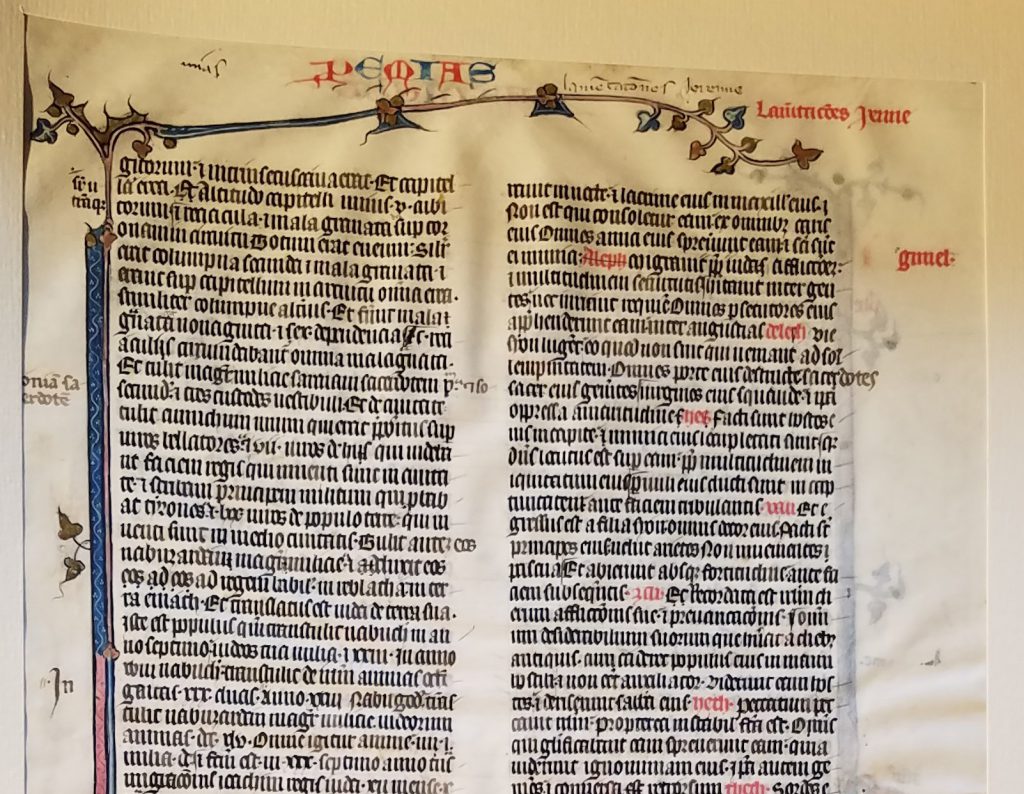
Set 1 of Ege’s FOL Portfolio, Leaf 14 recto top.
2) Opening of the Biblical Book
Lamentations 1:1 opens at the bottom of column a on the recto with a rubricated 3-line title and the inset 8-line initial Q of Quomodo. Set within a rectangular frame, the bow of the initial encloses a scene with a part-length standing male figure standing, with his left hand raised to the side of his face in a gesture of sorrow, to the left of a walled and domed architectural structure.
In thin black ink, a correcting hand effects multiple changes. Among them is the striking out of last phrase of the preceding text and the rubricated title with horizontal lines, plus the entry of aleph in the intercolumn atop the chapter number I.

Set 1 of Otto Ege’s FOL Portfolio, Leaf 14 recto bottom.
3) Running Titles, Continued
On the verso, the correcting hand spells out the name of the Book, all on the left-hand page of the original 2-page spread. The confused running title in red and blue capitals — LANIEUTI[?] — received the corrected (and partly abbreviated) form lamentationes.
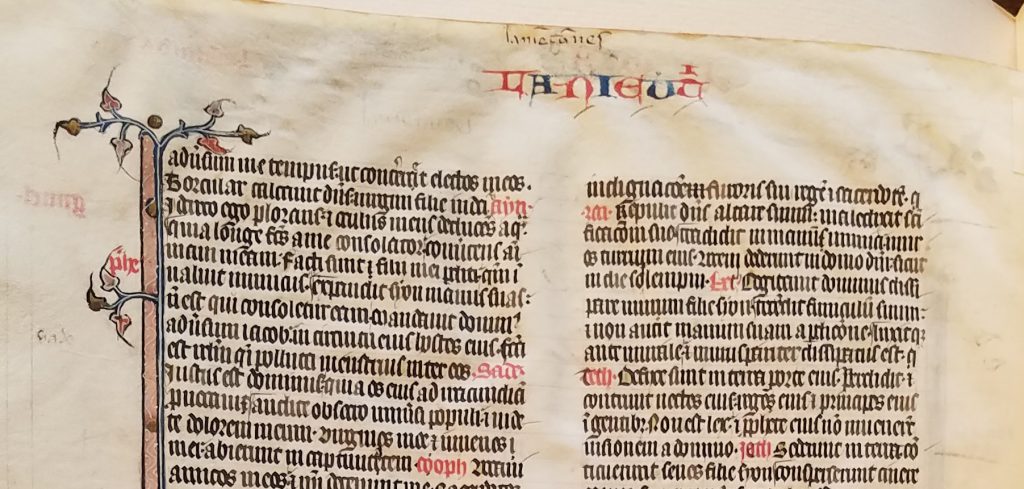
Set 1 of Otto Ege’s FOL Portfolio, Leaf 14 verso top.
4) Chapter 2 Begins
A lesser decorated initial, with an inset 3-line body, opens the chapter.

Set 1 of Ege’s FOL Portfolio, Leaf 14 verso lower.
*****
Ege MS 19
Portable “Lacaita Bible” in the Latin Vulgate Version
Italy, circa 1275, with illuminations made apparently in France
From the collections of Sir Joseph Lacaita (1813–1895) and of his son Charles Carmichael Lacaita (1853–1933); sold at auction at Sotheby’s, London, on 20 July 1936, as lot 20; and subsequently dismembered.
Recto in Ege’s Mat with His Printed Label
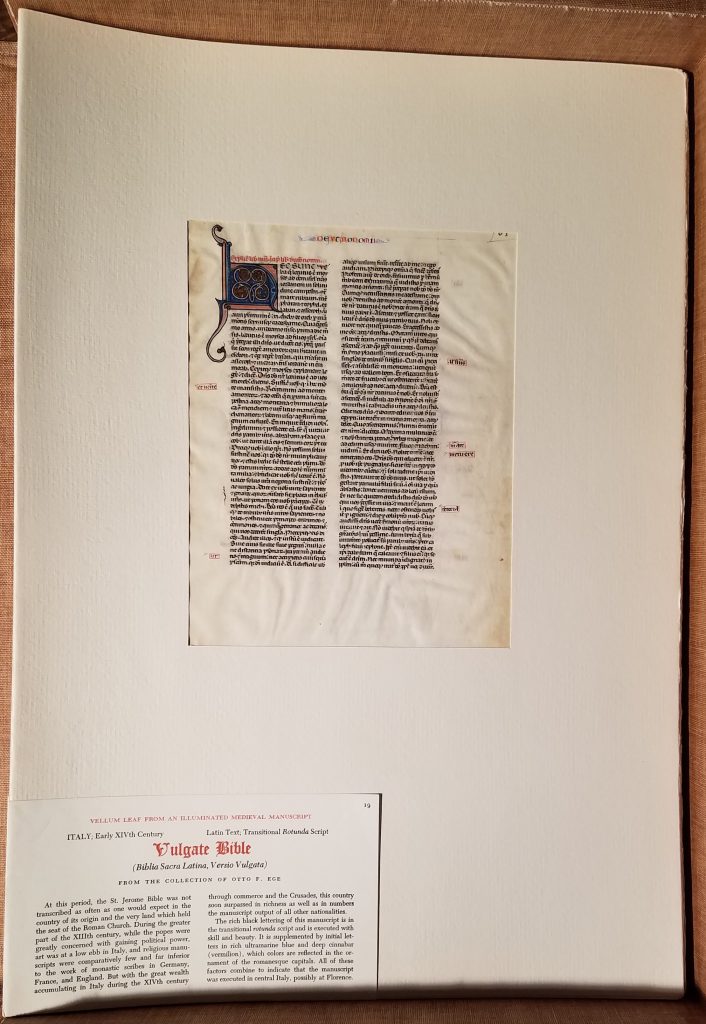
Set 1 of Ege’s FOL Portfolio, Leaf 19 recto in mat.
Recto Unveiled
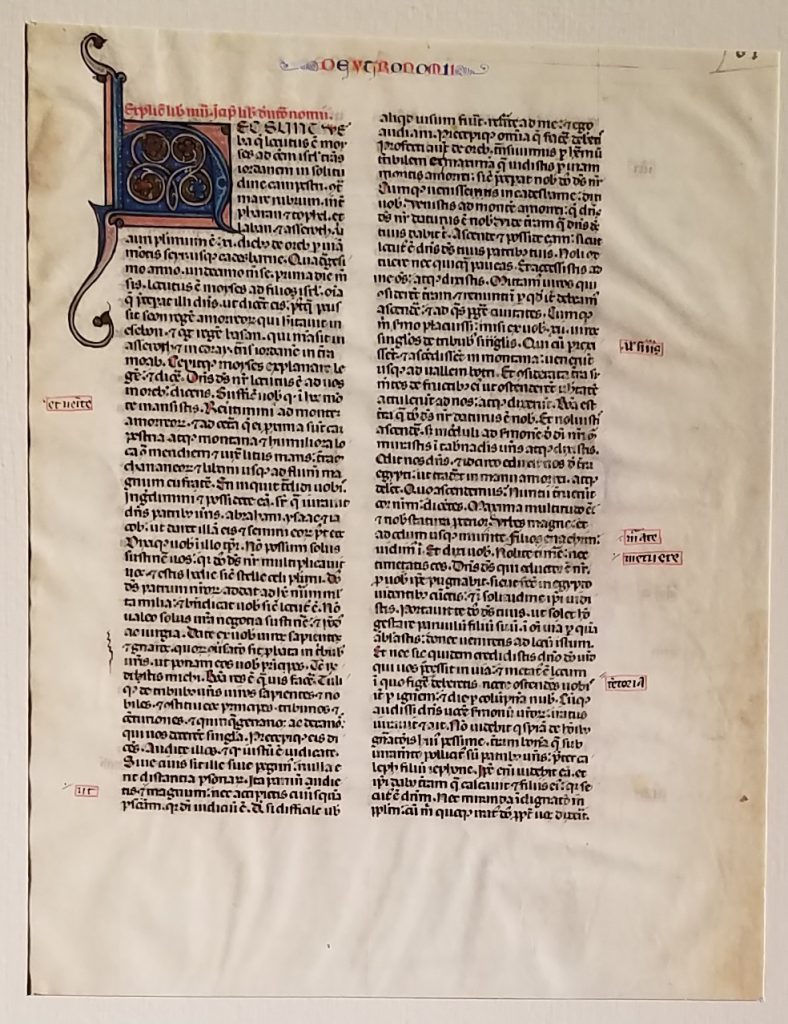
Set 1 of Ege’s FOL Portfolio, Leaf 19 recto.
Verso
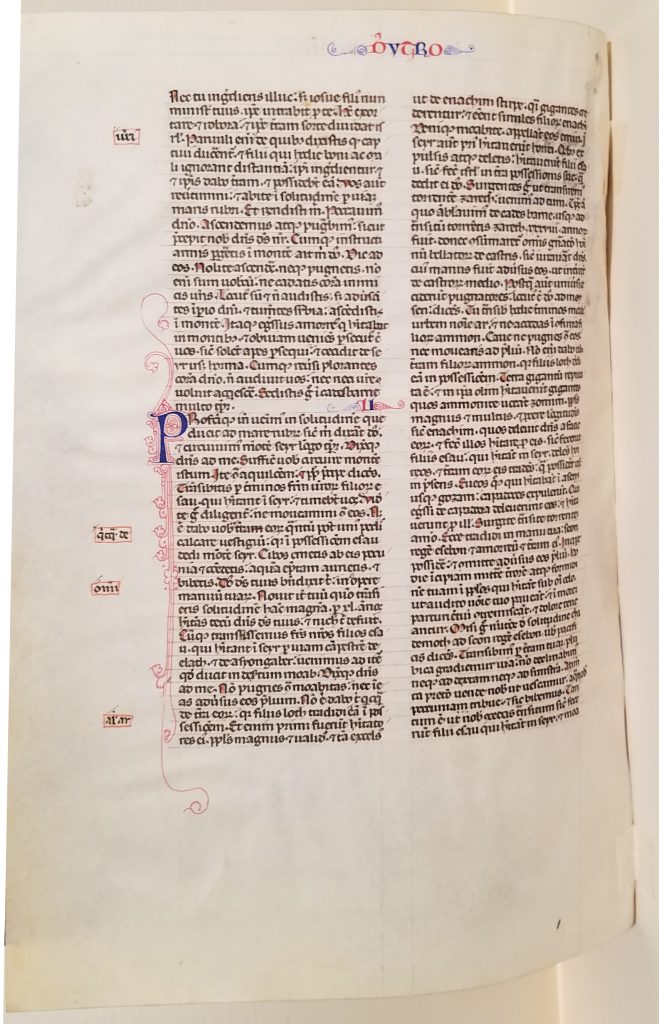
Set 1 of Ege’s FOL Portfolio, Leaf 19 verso.
Contents
This specimen is the first leaf of the Book of Deuteronomy in the Old Testament portion of the Bible. Its recto opens with the rubricated first line, which combines the concluding title of the preceding Book and the opening of the Book of Deuteronomy: Explicit liber numeri. Incipit liber deuteronomii. There follows the inset 8-line decorated initial H of Hac of Chapter 1. Chapter 2 opens on the verso in column a, with the inset 2-line initial P of Profectique. The text on the leaf breaks off abruptly mid-verse in 2:29: et moa[/-bitae qui].
In my preliminary reconstruction of the sequence of the surviving leaves within the former manuscript (see A Leaf from ‘Otto Ege Manuscript 19’ and Ege’s Workshop Practices), the leaf would have stood between these two, at the end of the 5 Books of the Pentateuch (following the Book of Numbers), and several Books before Kings:
Kent State University
Leviticus 27:10-34 and Numbers 1:1-20 on the recto (the verso is at present unavailable to view)
University of Minnesota
III Kings 22:30 – IV Kings 1:6
— with the original recto turned to the verso, so as to display the Book initial on the front of the leaf within Ege’s mat
Ege’s choice and presentation of the leaf in his mat concords with his customary practice for this dismembered manuscript, to judge by the survivors from the Portfolio or elsewhere. A leaf from the beginning of a Biblical Book, with an enlarged and especially decorated initial, is selected, and the side of the leaf with the more significant decoration appears on the front, whether that side is the original recto or not.
Details
1) Opening the Leaf and the Book of Deuteronomy
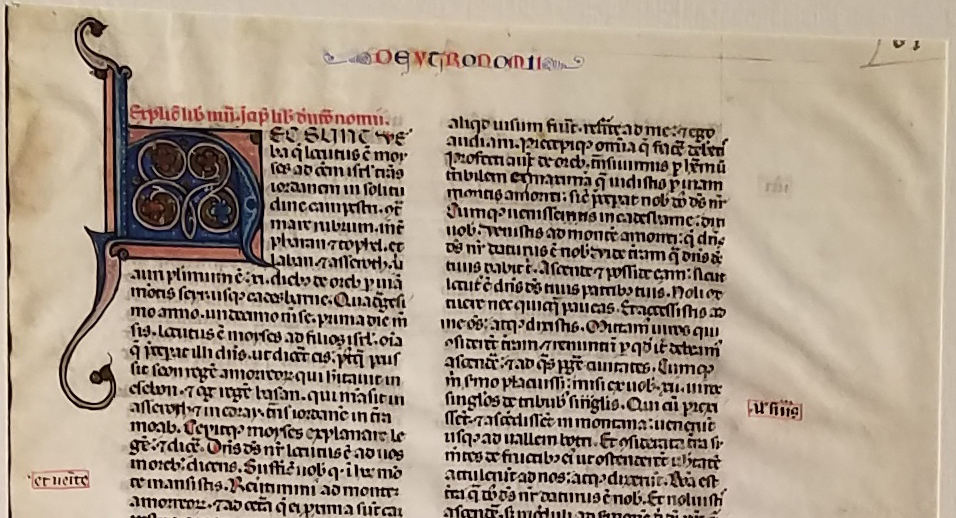
Set 1 of Otto Ege’s FOL Portfolio, Leaf 19 recto top.
2) Title and Initial for Deuteronomy 1:1
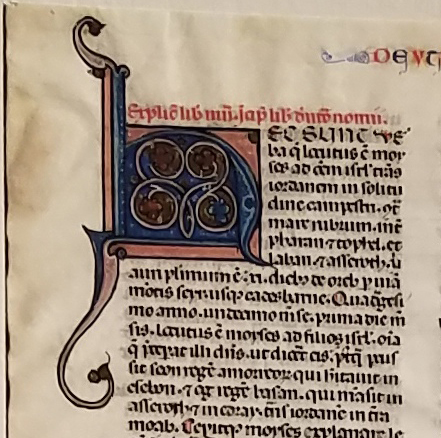
Set 1 of Otto Ege’s FOL Portfolio, Leaf 19 recto: Deuteronomy title and initial.
3) Initial for Deuteronomy 2:1
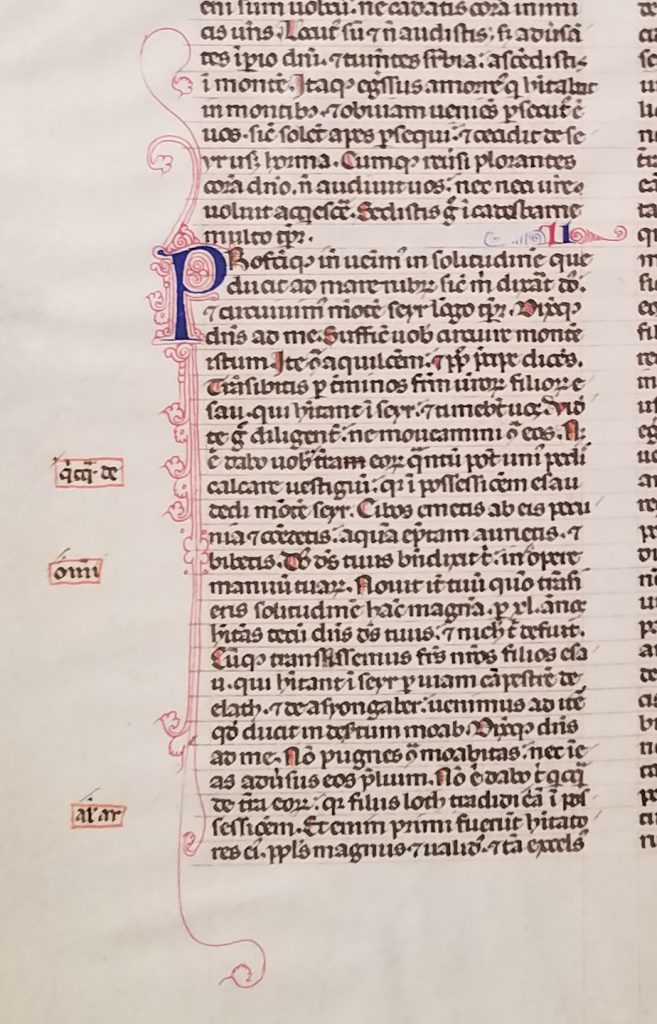
Set 1 of Ege’s FOL Portfolio, Leaf 19 verso: Initial for Deuteronomy 2:1.
*****
Ege MS 41
Copy of the Dialogues of Gregory the Great and Other Authors’ Works
(Now also Hugo of St. Victor)
Produced probably in Flanders, perhaps circa 1450
In reporting previous discoveries for this manuscript (see More Discoveries for ‘Otto Ege Manuscript 41’), including its own contents list atop the first page of text, I have called it “A Latin copy of the Dialogues of Gregory the Great, Epistles and Homilies of John Chrysostom, Meditations of Anselm, And Maybe More”. That list, written in a medieval hand, appears on specimen Leaf 14 in FOL Set 3, the “Ege Family Portfolio”, now in the Beinecke Rare Book & Manuscript Library.
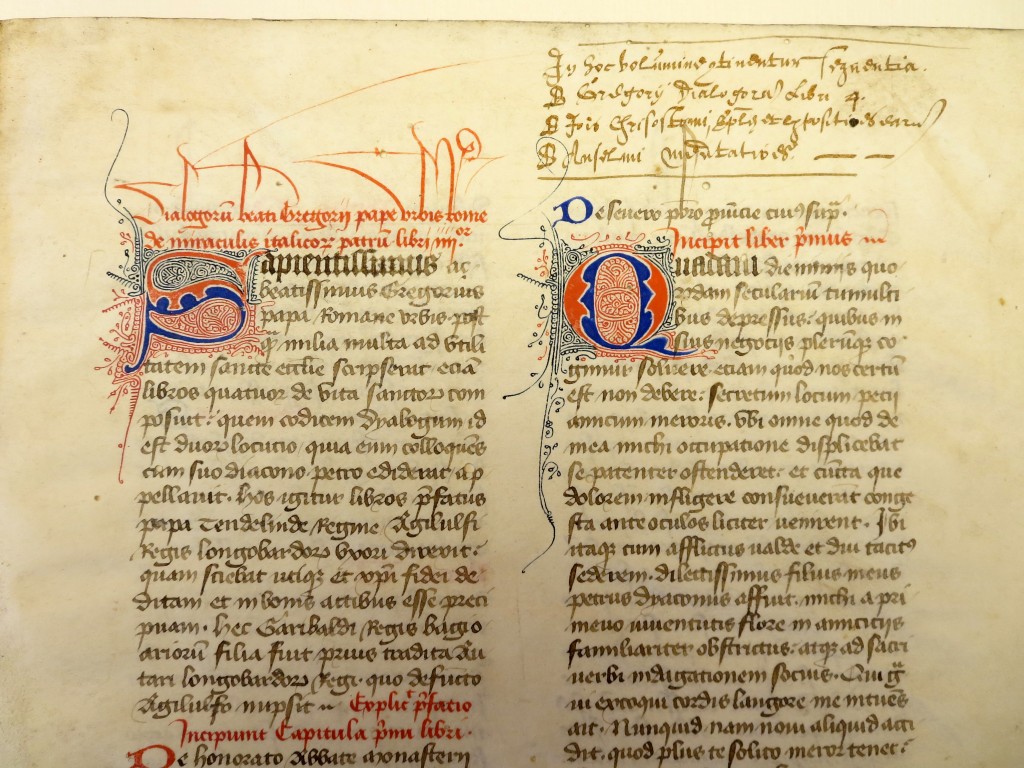
Leaf 41, Recto, Top, in the Family Album (Set Number 3) of Otto Ege’s Portfolio of ‘Fifty Original Leaves’ (FOL). Otto Ege Collection, Beinecke Rare Book and Manuscript Library, Yale University. Photograph by Mildred Budny.
In Ege’s Mat with His Label
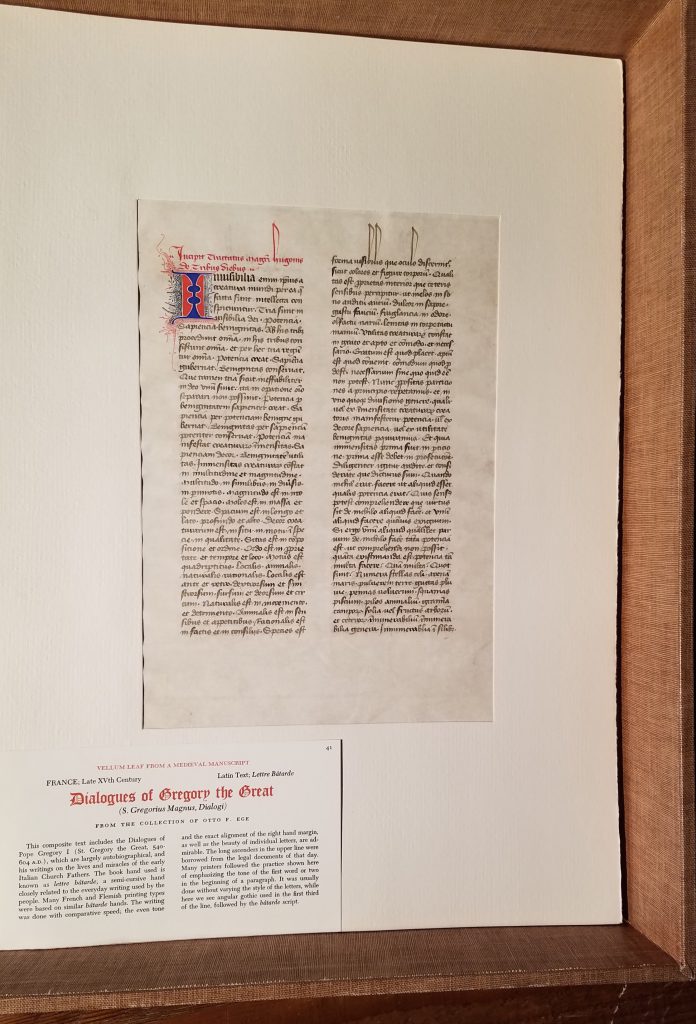
Set 1 of Ege FOL Portfolio, Leaf 41 recto in Ege’s Mat with Label.
Recto
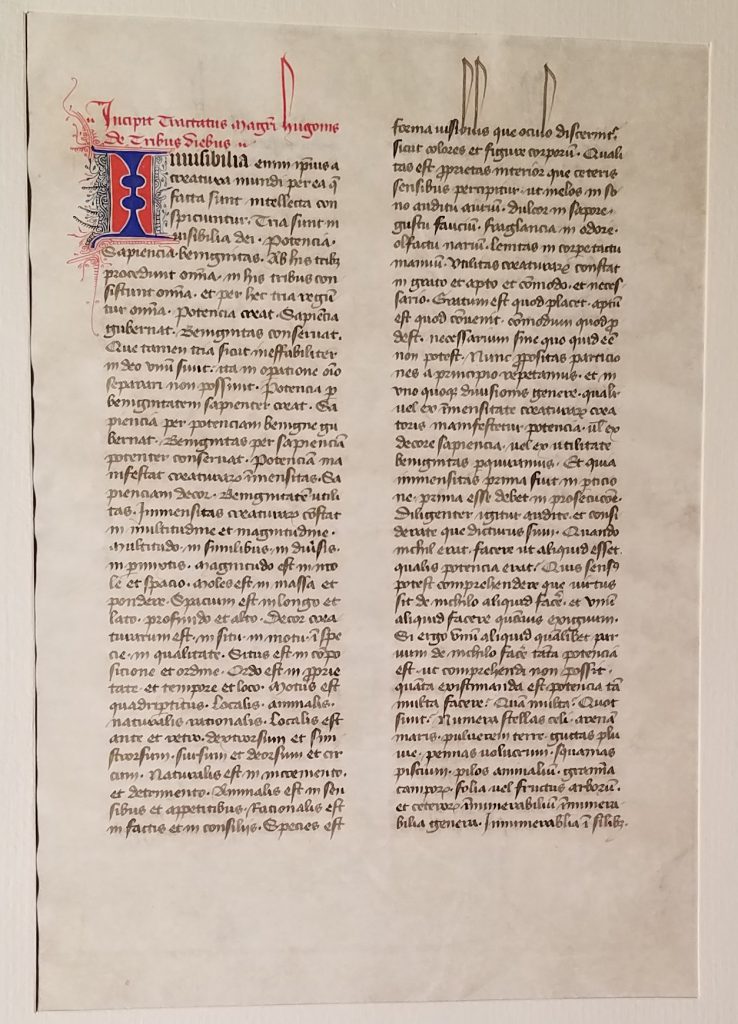
Set 1 of Ege FOL Portfolio, Leaf 41 recto.
Verso

Set 1 of Ege FOL Portfolio, Leaf 41 verso.
Details
1) Opening Title and Initial
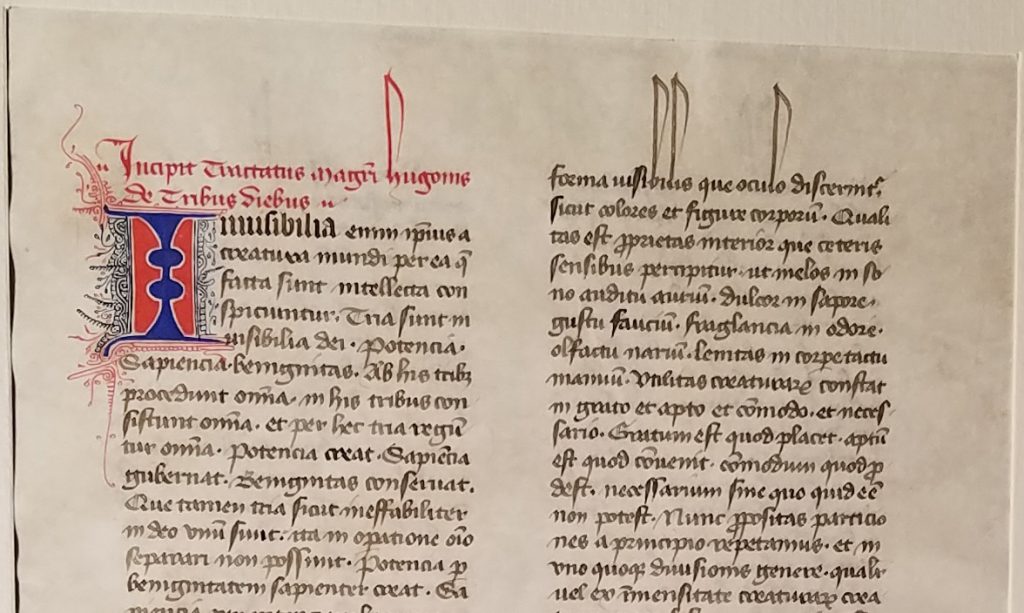
Set 1 of Ege FOL Portfolio, Leaf 41 recto, top.
2) Turning the Page
The verso continues the scribe’s habit of deploying extended ascenders.
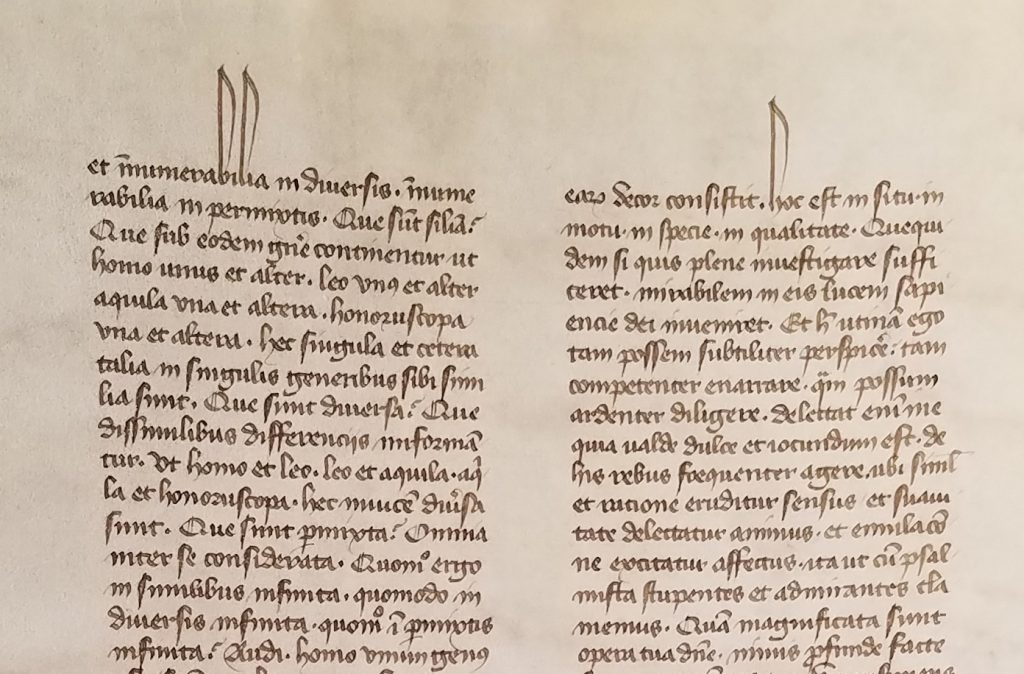
Set 1 of Ege FOL Portfolio, Leaf 41 verso top.
3) Closing the Verso
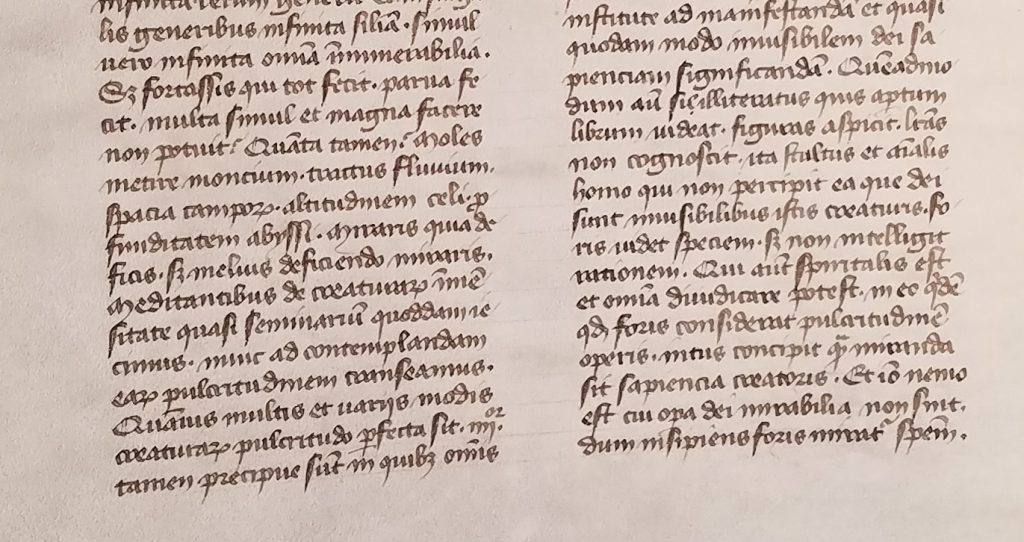
Set 1 of Ege’s FOL Portfolio, Leaf 41v, bottom.
Contents
Written by the same scribe as the other leaves known from the manuscript, this leaf opens the Tractatus Magistri Hugonis de Tribus Diebus (“Treatise of Master Hugh on the Three Days”). Given the subject, might the plural ablative Diebus be intended for Deis (“Gods” or “Divinities”)?
Headed by its 2-line rubricated opening title (“Here begins the Tractatus . . . “), the text begins with an enlarged inset 5-line initial I of Invisibilia. The verso closes with Et ideo nemo est cui opera dei mirabilia non sint dum insipiens in eis solam moratur speciem (“And therefore there is no one to whom the works of God are not wonderful, so long as the foolish dwells in them only as an appearance”).
A similar title opens texts of various lengths in other extant manuscripts of various dates, as catalogued, for example, at Durham, Oxford, and Worcester in England, at Soissons in France, and at Berlin and Mainz in Germany. But some of them begin their texts differently, with Verbum bonum . . . et visum est per id quod fecit, before turning to Invisibilia enim ipsius a creatura mundi . . .
Beginning instead directly with Invisibilia enim ipsius (a quotation from the Pauline Epistle to the Romans, 1:20), the version of De Tribus Diebus on Leaf 41 of Set 1 corresponds with items with the same title reported, for example, in
- Bodleian Library, Laud MS 277, item 14
- Mainz, Stadtbibliothek, MS I 23, folios 128ra–136va
- Berlin, Phillipps MS 2000, folios 8v–12r
Most of these witnesses make it clear, by his name and/or the setting of a series of his works, that the “Magister Hugo” assigned to the title is the Saxon theologian and mystic Hugh of Saint Victor (circa 1096 – 1141). Depending upon the modes of circulation of the text, this treatise or extract derives from, or stands separately from, his monumental Didascalicon (“Teaching”), or Eruditionis Didascalicae Libri Septem (“Seven Books of Didactic Education”).
Composed in the late 1130s, the text of the Didascalion offers a survey of the important spheres of human knowledge, in seven or six Books. As printed in the Opera . . . of Hugh of Saint-Victor in Patrologia Latina, Cursus Completus. Series Latina, volume 176 (1880), the text in seven Books spans columns 740–839. (Also online: HSV-Didascalion.pdf.)
An English translation for Books I–VI only, with introduction and notes, is supplied by Jerome Taylor in The Didascalicon of Hugo of St. Victor: A Medieval Guide to the Arts (New York: Columbia University Press, 1961 and 1991).
The work which circulated as De Tribus Diebus is sometimes attached as Book VII to the Didascalion, both in some manuscripts and printed editions. Its extract or “treatise” opens with Chapter I — beginning at column 811 in the edition of PL 176, wherein it has the title or heading: De tribus invisibilibus Dei, a quibus emanant omnia, quae sunt potentia, sapientia, benignitas (“Of the three invisible things of God, from whom emanate all things, which are Power, Wisdom, and Kindness”). On the complexity of the text of the treatise in its own right and within the oeuvre of its author, see, for example:
- Wanda Cizewski, “Reading the World as Scripture: Hugh of St Victor’s De Tribus Diebus“, Florilegium, 9 (1987), 65–88, online via Wanda Cizewska, Reading the World as Scripture.
In the newly discovered Leaf 41 in Set 1 of Ege’s FOL Portfolio, the text of the treatise breaks off at the end of the verso within the edition’s Chapter IV (in PL 176, column 814C). Accordingly, the next leaf might have picked up at this point, starting with Sapiens autem per id quod foris vidit profundam rimatur divinae sapieniæ cogitationem . . . (“But the wise man, through what he sees outwardly, searches for the profound thought of divine wisdom”).
“Author Portraits”
Magister Hugo contemplates the opening of his text, in an enthroned “author portrait” which forms the frontispiece for a copy of the Didascalicon made at Fulda between 1176 and 1177.
Leiden, Bibliothek der Rijkuniversiteit, MS Vulcanianus 46,folio 130r. Magister Hugo composes his ‘Didascalion’. Image Public Domain via Wikimedia Commons.
Hugh of Saint-Victor teaches from his book in an elaborate architectural setting for the frontispiece of De Arca Morali. in a copy of his collected works made at St. Albans Abbey in the second half of the 1th century: Oxford, Bodleian Library, Laud MS 409, folio 3v.
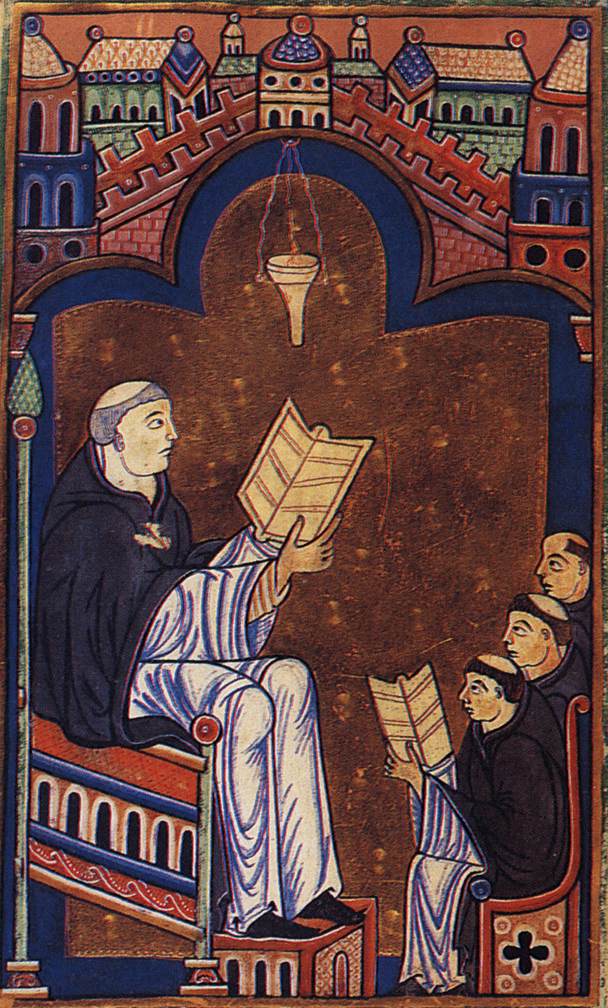
Oxford, Bodleian Library, Laud MS 409, folio 3v. Hugh of Saint-Victor as author and teacher in the frontispiece to De Arca Morali.
The Place in the Former Volume
My efforts to reconstruct the sequence of surviving leaves within the former manuscript of texts by Gregory the Great and others, to which the leaf from Hugo St. Victor belonged, has further to go. First, I focused upon the portion with the Dialogues of Gregory the Great, then began to move onto the portion with Commentaries on Epistles by, or attributed to, Johannes Chrysostom in Latin translation. So far no leaves are recognized from a portion with the Meditations of Anselm. See
Given the sequence of items in the medieval contents list on Leaf 41 in Set 3 of the FOL Portfolio (see above), it seems reasonable to assume that Gregory’s Dialogues preceded Chrysostom’s Commentary on Epistles, followed in turn by Anselm’s Meditations.
The presence of the Tractatus by Hugh of Saint-Victor in the volume comes as a surprise. The “find-place” of this leaf in the position of Leaf 41 in Set 1 of the FOL Portfolio establishes that it came from Ege’s dismembered manuscript, and no other volume whatsoever containing perchance the work of the same scribe, using the same format and layout to copy a text on religious subjects by another major Christian author.
Recognizing its place within the volume — which Ege dismembered and distributed variously, after acquiring it from England, whence it had come after it had been plundered from Flanders in World War I — amounts to the fitting together some pieces of a jig-saw puzzle.
Under the circumstances, now that the leaf has come to light through the generosity and collegiality of the owner and dedicated “Fragmentologists”, it seems appropriate that the decorated initial I of Invisibilia, embellished with pen-line flourishes in red and blue pigment, employs within its core the interlocking pieces of jig-saw ornament.
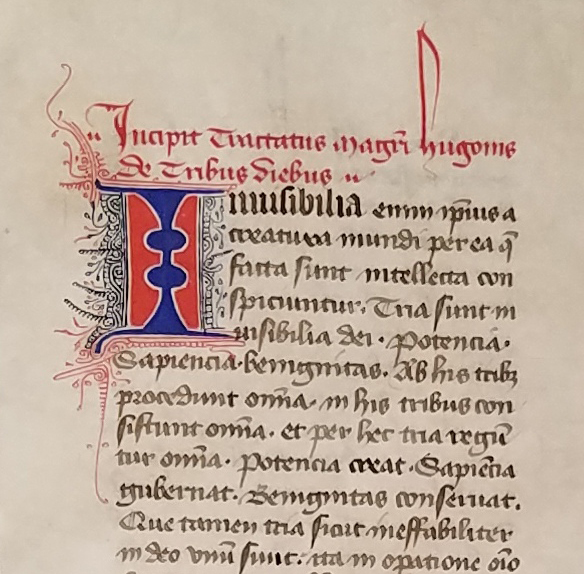
Set 1 of Ege FOL Portfolio, Leaf 41 recto top left.
*****
We thank the owners, individuals and institutional, who have permitted us to examine and publish their Ege Manuscript Leaves during the long-term research process. We thank the owner of Set 1 of the FOL Portfolio for providing these images as a vehicle for study, and we thank Lisa Fagin Davis for sharing them for consideration.
We look forward to learning more about the other Leaves in Set 1. A few tantalizing glimpses: Manuscript Road Trip: Otto Ege, St. Margaret. and Digital Fragmentology, Part 2. Nice!
See also our reports on other Ege manuscripts:
- Updates for Some ‘Otto Ege Manuscripts’ (Ege MSS 8, 14, 41, and 61)
- Ege MS 56: See “From Cover to Cover, the Symposium Booklet for our 2020 Spring Symposium Booklet (Figure 5 and caption), “From Cover to Cover”, for the 2020 Spring Symposium, available freely for download.
See also ‘Otto Ege’s Manuscripts’: Reflections on Methodologies of Discovery.
Note that more reports are on the way.
*****
Please let us know your suggestions and feedback. Add your Comments here, Contact Us, and visit our Facebook Page.
Watch this space and follow our blog for further research on dispersed manuscripts, those of Otto Ege included.
*****

No. 48 in the new portfolio is something particularly special. I ve noted before that these portfolios almost always contain only text pages, not miniatures, because they were assembled as paleographical specimens. Ege and his sometime-partner Philip Duschnes would have sold the miniatures from these manuscripts separately. But set no. 1 is unusual, perhaps because it is in fact the first set; in this box, leaf 48 is a miniature.

Tamiflu recently posted…SUBJ1No. 48 in the new portfolio is something particularly special. I ve noted before that these portfolios almost always contain only text pages, not miniatures, because they were assembled as paleographical specimens. Ege and his sometime-partner Philip Duschnes would have sold the miniatures from these manuscripts separately. But set no. 1 is unusual, perhaps because it is in fact the first set; in this box, leaf 48 is a miniature.
[…] 26.6.2020 http://manuscriptevidence.org/wpme/some-leaves-in-set-1-of-eges-fol-portfolio/ […]
Thank you for your comments.